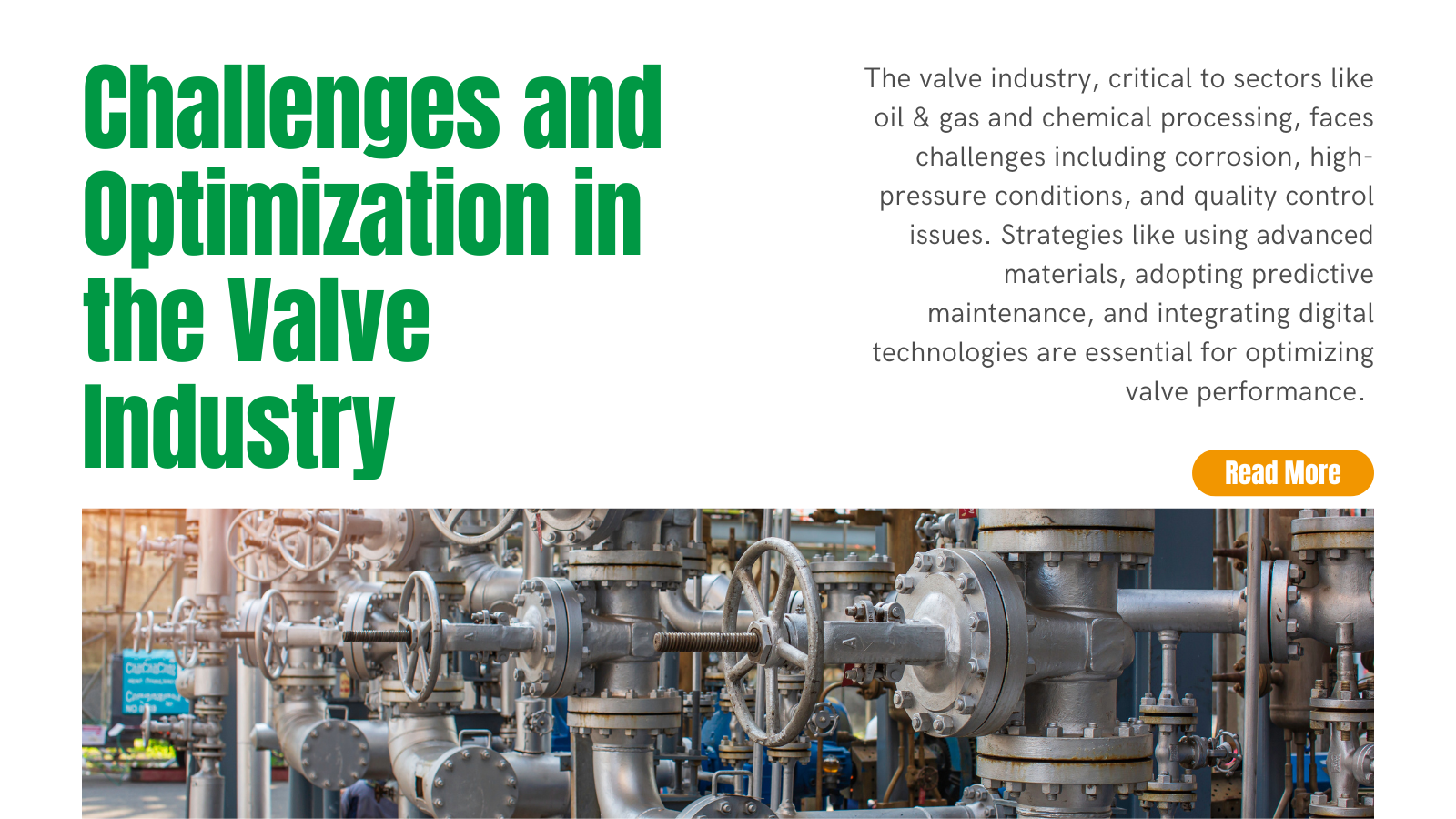Navigating the Roadblocks: Challenges and Optimization in the Valve Industry

The valve industry is integral to a variety of sectors such as oil & gas, chemical processing, water treatment, and power generation. Valves play a critical role in ensuring operational efficiency and system safety. However, this industry is rife with challenges that can impact performance and reliability. Optimizing valve operations is essential to overcoming these challenges, especially as industries continue to evolve technologically.
In this article, we explore key challenges faced by the valve industry and the expert insights that provide strategies to address them. From materials selection to digitalization, the solutions offered here aim to improve valve performance, ensure operational efficiency, and unlock optimization in this ever-critical industry.
Common Challenges in the Valve Industry
- Corrosion and Erosion
- Challenge: Valves exposed to harsh environments, such as corrosive and abrasive media, are prone to material degradation and failure.
- Solution: Engineers must choose corrosion-resistant materials like stainless steel, Monel, and Hastelloy to extend valve lifespans. Coatings such as PTFE can also enhance resistance in highly corrosive environments.
- High-Temperature and Pressure Conditions:
- Challenge: Extreme temperature and pressure in industries like oil & gas and chemical processing cause wear and tear on valves, potentially leading to malfunctions.
- Solution: Selecting high-strength materials such as Inconel or titanium ensures durability in extreme conditions. Regular maintenance checks and advanced seals (e.g., metal-to-metal seals) can reduce leakage risks.
- Inconsistent Quality Control:
- Challenge: Inconsistent manufacturing standards and poor quality control can result in defective valves, leading to premature failures.
- Solution: Strict adherence to international standards (e.g., ASME, API), performance testing (e.g., pressure testing), and automated quality monitoring are essential for ensuring valve reliability.
- Valve Sizing and Selection Errors:
- Challenge: Incorrect sizing or selection of valves can lead to system inefficiencies and increased downtime.
- Solution: Rely on accurate system data (e.g., flow rates, pressure drops) and valve sizing software to minimize errors. Custom solutions tailored to specific applications may also reduce selection risks.
- Automation and Digitalization:
- Challenge: Older valve designs struggle to integrate with automated systems, complicating efforts to optimize performance in Industry 4.0 environments.
- Solution: Implementing smart valves with sensors for real-time monitoring, predictive maintenance algorithms, and IIoT integration is critical for automating operations and minimizing downtime.
Strategies for Optimizing Valve Operations
- Advanced Materials Selection:
- Choosing the right materials is essential for durability and resistance to corrosion and temperature fluctuations. For instance, titanium alloys balance strength and corrosion resistance, while composite materials work well in low-pressure environments.
- Maintenance and Monitoring:
- Regular maintenance is vital for extending valve life. Implementing predictive maintenance strategies using real-time condition monitoring (e.g., sensors tracking pressure and temperature changes) helps detect potential issues early and avoid unexpected failures.
- Valve Design Optimization:
- Ball valves are preferred for their excellent sealing and low friction.
- Butterfly valves are beneficial for space-saving and weight reduction in certain systems.
- Digital Twins and Simulation
- Digital twins create virtual models of valve systems, simulating performance under various conditions. This allows engineers to identify potential failure points and optimize performance before physical implementation.
- Customization for Specific Applications:
- Working closely with manufacturers to create customized valve solutions ensures the selected valves align perfectly with the specific operational requirements, enhancing overall system efficiency.
Optimizing valve design improves flow characteristics, reduces leakage, and minimizes wear. For example:
Overcoming Roadblocks in Valve Industry Optimization
While optimization promises significant benefits, several obstacles must be addressed:
- Resistance to Change: High costs and the need for skilled labor slow the adoption of automation and digitalization in many industries.
- Supply Chain Disruptions: Global supply chain issues can delay valve manufacturing and maintenance, causing operational downtimes.
- Regulatory Hurdles: Different regions impose varying regulatory requirements on valve production, complicating compliance for global manufacturers.
- Solutions: Investing in employee training, collaborating with regulatory bodies, and developing contingency plans for supply chain disruptions are necessary to overcome these roadblocks.
Case Studies: Successful Optimization
- Chemical Processing Plant: By upgrading to Hastelloy valves, a chemical plant improved system reliability by 50% and reduced maintenance costs.
- Offshore Oil Platform: Implementing predictive maintenance with smart valves helped reduce valve failures by 30% and improved uptime by 15%.
Tools and Technologies for Valve Industry Optimization
- Digital Twins: Virtual simulations of valve systems help engineers test various performance scenarios before physical implementation.
- Smart Sensors: These sensors offer real-time insights into valve health and performance, enabling proactive maintenance and reducing downtime.
- AI-Driven Analytics: AI tools analyze vast amounts of data from valve systems, identifying trends and optimization opportunities to improve overall efficiency.
Conclusion: The Future of Optimization in the Valve Industry
The valve industry is on the cusp of transformation, driven by advancements in automation, digitalization, and material science. By embracing these technologies, companies can overcome existing challenges and unlock optimization, ensuring enhanced efficiency, reliability, and productivity across critical applications.
By addressing roadblocks such as supply chain disruptions, regulatory issues, and resistance to change, the valve industry can continue to innovate and thrive, securing a future of seamless operations and continuous improvement.
